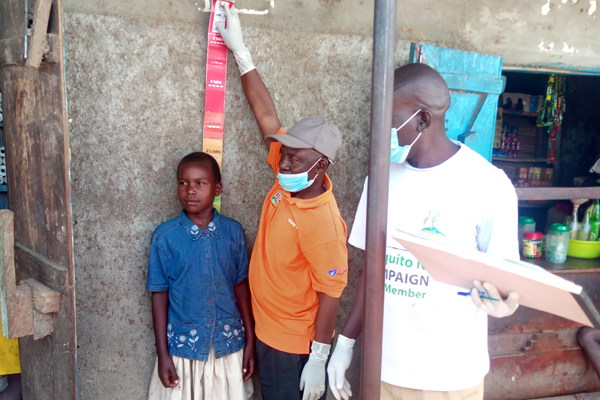Bilharzia hits Teso landing sites – survey

VHTs in Nkombe B village Imanyiro Sub-county Mayuge District take a girl's height before administering drugs to fight Bilharzia. PHOTO/ PHILIP WAFULA
What you need to know:
The outbreak is blamed on consumption of contaminated water.
More than 50 percent of people living in landing sites on the shores of Lake Kyoga in Kaberamaido District, Teso Sub-region, suffer from bilharzia, a survey has found.
At least six landing sites are affected. These include Akampala Alau, Apai, Bugoi, okile, murem, and kitoko nacebwe.
The survey, which was commissioned by the district this year, also found that 60 percent of pupils at Okola Primary School have contracted the disease through consuming contaminated water from the lake shores.
In an interview with Daily Monitor, on Monday, Ms Grace Tino, the district health educator, said the survey revealed that children between the age of 14 and 18, and other older persons over the age of 20 are the most affected.
She said in Obajai Village in Okile Sub-county, the infection rate stands at 29.2 percent of every 100 persons tested, while in Alua B Village in Ochero Sub-county, it stands at 9.6 percent of every 100 persons tested and in Agule Village in Kobulubulu Sub-county, the infection rate stands at 52 percent of every 100 persons tested.
She blamed the issue on the consumption of contaminated water by the public.
She added that Akampala Landing Site in Ochero Sub-county, with 1,800 people living in and around it, has one of the biggest bilharzia infections as a result of the lack of sanitary facilities such as pit-latrines.
“In most cases, these people defecate at the lake shore and that explains why the rate of the outbreak of bilharzia is so high,” Ms Tino said.
Dr Ronald Opito, a lecturer at Soroti University’s department of public health, said the institution has partnered with districts in Teso Sub-region to ensure that preventable diseases such as bilharzia don’t become a burden in the communities.
“Prevention is the best way to ensure a healthy life, and in medical practice, that is the culture we demand the communities to develop,” Mr Opito said.
About bilharzia
Schistosomiasis, also known as bilharzia, is an infection caused by a parasitic worm that lives in fresh water in subtropical and tropical regions.
You can become infected if you come into contact with contaminated water and the tiny worms burrow into your skin.
Symptoms include a high temperature (fever), an itchy, red, blotchy and raised rash, a cough, diarrhoea, muscle and joint pain, tummy pain and a general sense of feeling unwell.
However, Many people with schistosomiasis don’t have any symptoms, or don’t experience any for several months or even years.
Source: National Health Service



